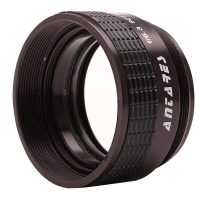
The Antares f/6.3 Focal Reducer for Schmidt-Cassegrain Telescopes is a low-price option for reducing the focal length of your Schmidt-Cassegrain telescope from f/10 to f/6.3. This “speeds up” the optical train by reducing the focal length and magnification of the scope, requiring less time to integrate the same signal. A focal reducer along this line is probably the most common accessory bought for SCTs because for beginners, it makes tracking and imaging more manageable.
Specs
For the last few years it has been running between $80 and $95 and although discontinued by Antares, it still is available new from various vendors at the time of this writing (beginning of 2020). It consists of 2 identically-shaped convex lenses inside of the metal encasing, held in place by two threaded rings which screw into the inside of the casing.
It is roughly 33mm long, but about 9mm of that is male threading which ultimately ends up inside of another part. It is about 2 inches in diameter because the male (camera side) and female (telescope side) threads are standard SCT threas (2″, 24 TPI). This allows it to attach directly to the back of many SCTs like the 8se, and to have other SCT-threaded accessories attach to the other side. Note that many accessories are M42 threads, however, and will not fit on the camera side of this reducer without an adapter. The most common choice is a t-thread extension that has M42 threads on the other side.
Be careful for the backfocus distance, too. The focal length of this lens is roughly 220mm, leading to a necessary distance of 82mm from the front of the reducer to the imaging camera’s sensor; this only leaves around 49mm of distance from the back of the reducer to your imaging sensor, making the standard Celestron t-adapter far too long to place the sensor at the right place if you want to maximize its performance and get the exact right focal length for your telescope (remember that if you’re using a DSLR, you also have distance from the front of the camera body to the sensor to account for). This reduces aberrations and vignetting, too. Other distances are manageable, but lead to strong field flatness issues and different focal length reduction. I had it way farther out than this, which gave me 0.5x reduction which I liked, however the field is not even close to flat and the performance suffers.
Strengths and Weaknesses
In my years of using it, I can say that I know its capabilities well and I’ve found it to have the following strengths and weaknesses:
Pros:
- Very inexpensive for its class
- SCT threading conveniently attaches immediately
- Excellent optics for high-light situations like the moon and certain bright DSOs
- Great for visual use
Cons:
- Does little to correct for astigmatism or imperfect field flatness
- Lower quality optics start to show in fainter DSO images when images are strongly stretched
Strengths
This is a great piece of equipment for taking images with brighter subjects. Here are some examples:
All of the above were taken with the Antares focal reducer on the Celestron 8se SCT with a Nikon DSLR at prime focus. From an equipment perspective, they look great!
Weaknesses
However, where this focal reducer struggles is in hyper-stretched images with a weak signal such as deep sky work. Some brighter DSO targets are passable with this reducer, but it requires using aggressive background extraction and careful handling of the resulting imperfections.
Passable Cases
Here is an example of a raw light frame of M33 at a very dark site:
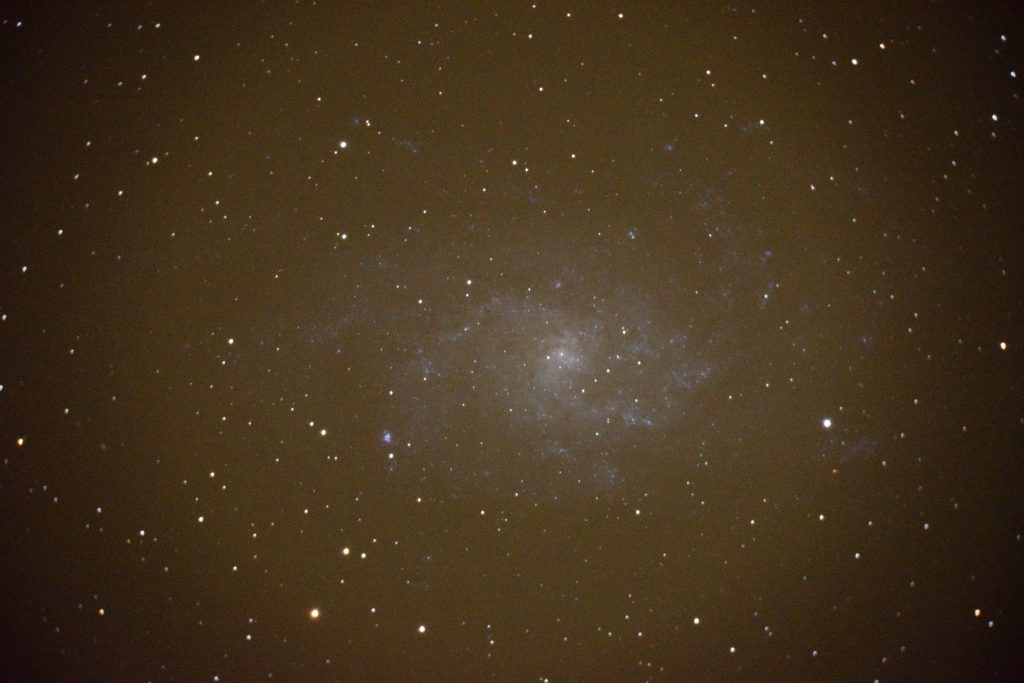
The brown cast is highly favorable; it indicates a very dark site. The galaxy is indeed a bluish tint. The image is vignetted as expected, and it’s also worth noting that I was not attentive in keeping the correct backfocus distance here, so the astigmatism (“swirling” rotation of the stars on the outer edges) and magnification are not to be compared to what is advertised or expected.
Now although the vignetting looks even and uniform as you move outward, it turns out it isn’t with this focal reducer. There are various imperfections and uneven gradients that are introduced into the optical train that are hard to correct. In this particular instance I was able to use aggressive background extraction to help the problem; here is the stack of just over an hour of data, calibrated with flats, with background neutralization and automatic background extractor applied in Pixinsight:
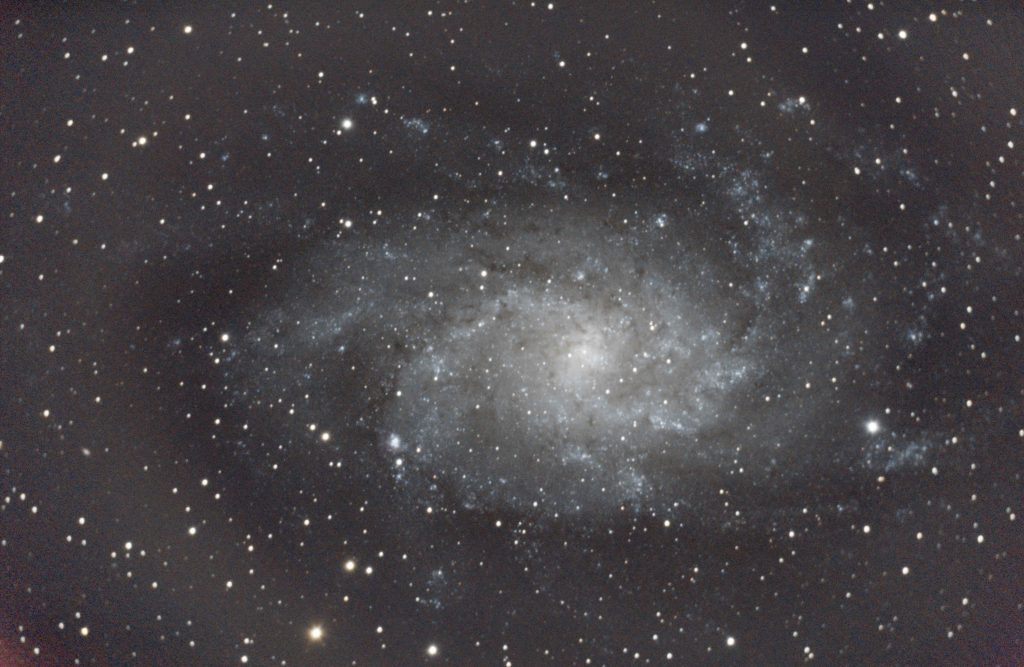
Despite well-taken flats (more on that on another post I’m sure), you can still see some of the circular artifacts introduced by the focal reducer upon stretching the image aggressively to show the finer details; note the “rings” of dark and bright sections as you get near the edge of the frame. It’s particularly dark just outside of the galaxy. This artifact is not caused by ABE in Pixinsight; it is removing an even, gradual gradient from the vignetted image to reveal darker and lighter sections that are very subtle.
After aggressive background extraction with dynamic background extractor, I was able to manage it fairly well in this image. Here’s a final result with this data:

Other scenarios were not so easy to handle, especially when the total integration time gets greater Even with dithering, these large artifacts really “add up” and get “amplified” in the stack (not literally so, but that’s the main effect). Let’s take some worst cases. Here is M13, with flat calibration, stacked, background neutralization, and automatic background extractor applied:
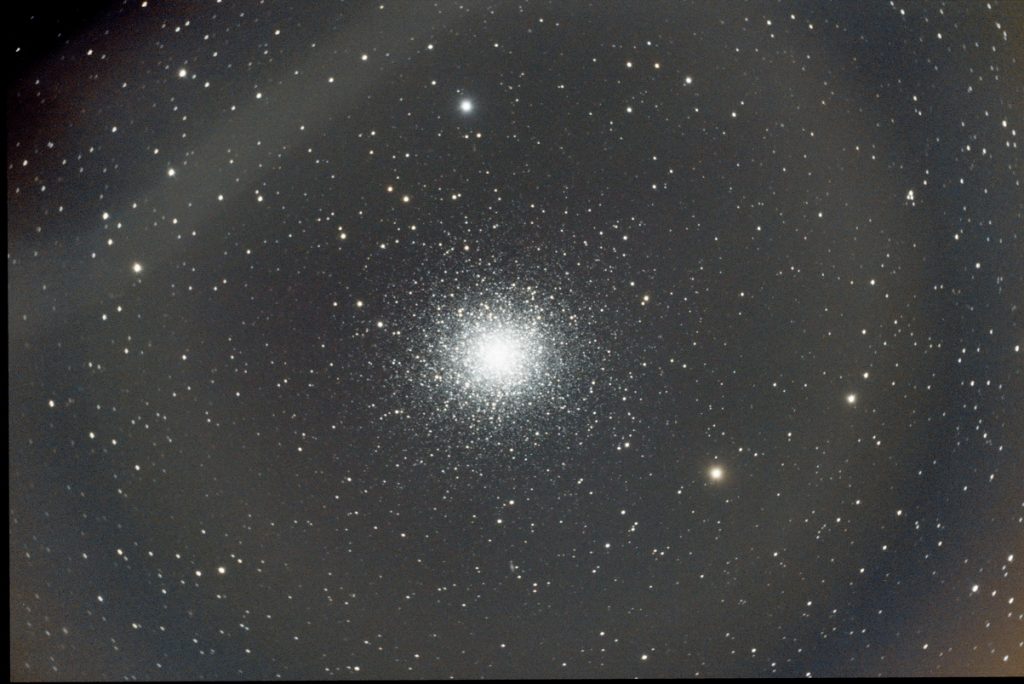
Note that the straight-line artifact in the upper left corner is NOT from the focal reducer; I hadn’t yet aligned the pick-off prism in my off-axis guider. The astigmatism is again exaggerated because the proper backfocus distance wasn’t respected. The ring artifacts are crystal clear here, and they go away entirely when the focal reducer is removed, all else kept the same.
Aggressive background extraction still produced a nice result that I like, however!
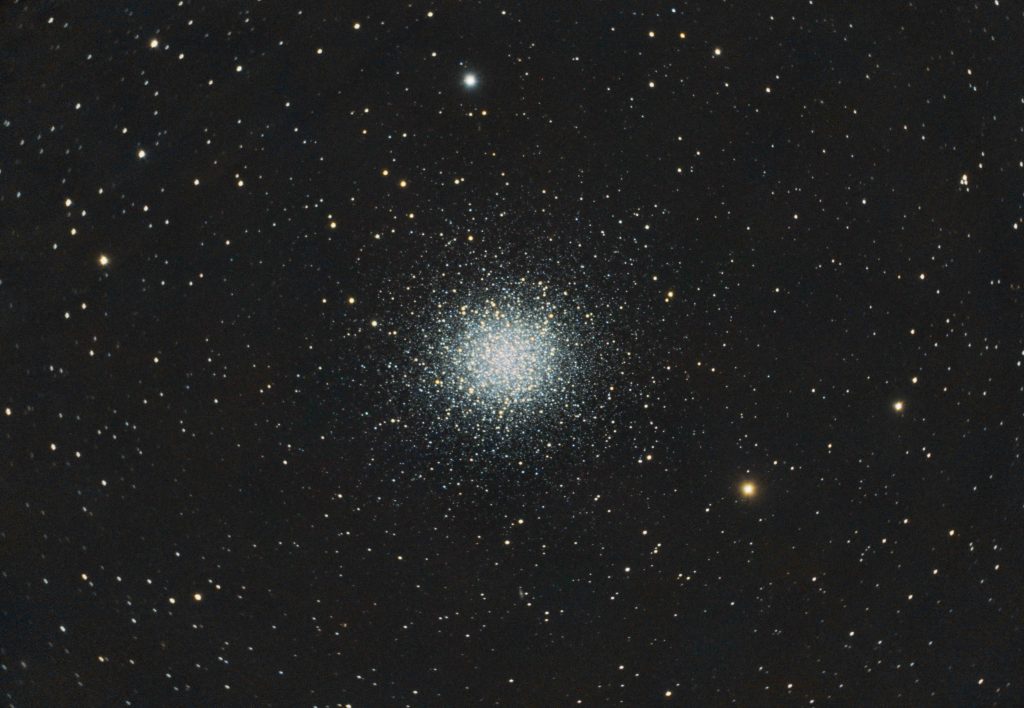
The pick-off prism artifact is still slightly present, and the splotchiness of the background is from a necessary aggressive background extraction, but the result is still admirable!
Less Usable Scenarios
There are less friendly cases, unfortunately. The M13 example has a lot of background to sample. Images that don’t have much background, however, with a lot more data than the M33 example, suffer much more and cannot have background extraction applied as successfully because there’s minimal “background” to sample. This leads to the subtraction of desired signal data. This is even worse when obtained in light pollution, it seems.
Here is a stack of data on the elephant trunk nebula, IC 1396, which contains nebulosity throughout the field of view, making background extraction difficult.

This is pretty much unusable. Not only are the rings present, but they have chromatic banding. Again, these issues hardly manifest without the reducer present, so nothing else in the optical train is really to blame.
What About Flat Correction?
Oh, if only. Turns out, the artifacts you see above in the less usable images are completely resistant to flat correction. My flat correction techniques are very meticulous and careful. I’ve also tried just about everything to try to reduce these artifacts with flats (of different exposures, different ISOs- turns out higher ISO flats are better but not perfect-, TV flats vs sky flats, more and fewer t-shirts, bias subtraction from the flats, etc.- trust me I’ve tried it all). None of them worked.
It should be shown that the above artifacts were present after flat subtraction, but were notably reduced by it. However, the flats cannot fully take care of them when the images get aggressively stretched. The flats help substantially.
Here is an integration of the crescent nebula that was calibrated with flats (automatic background extractor was applied in Pixinsight):

Turns out this was usable enough for the major details to come out, however this amount of chromatic ringing was way too much to handle easily without killing a lot of the background nebulosity here. Here is the result:
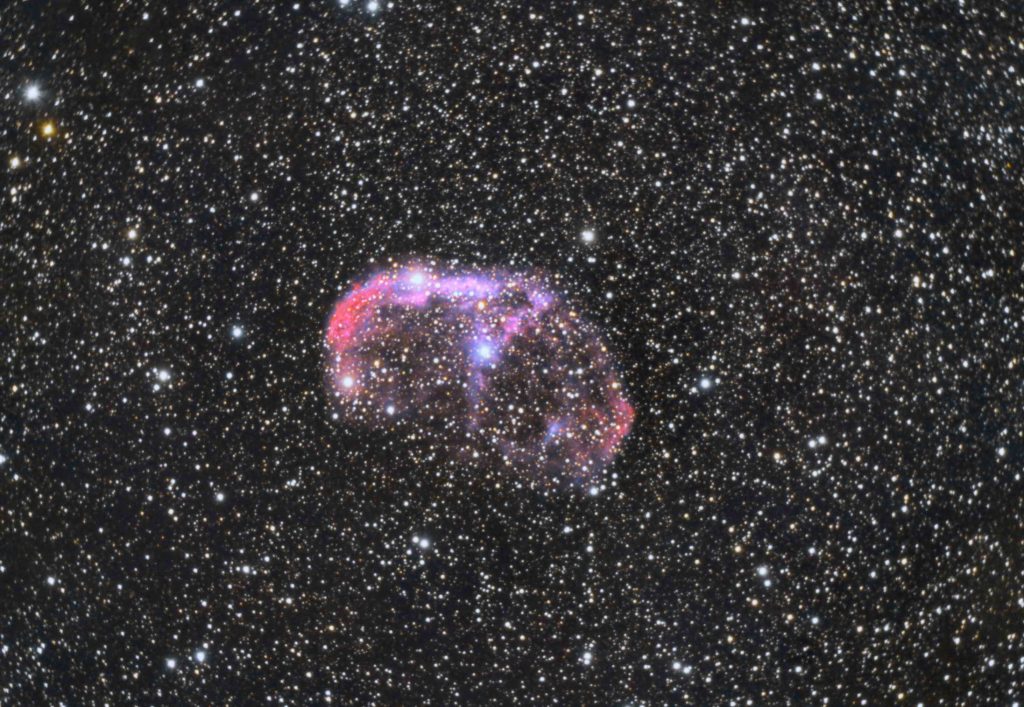
This was great for the stronger nebulosity in the center, but it misses much of the surrounding nebulosity as a result of the background extraction. However, more importantly for this section, here is the same image stack without flats (automatic background extraction applied twice and autostretched in Pixinsight):
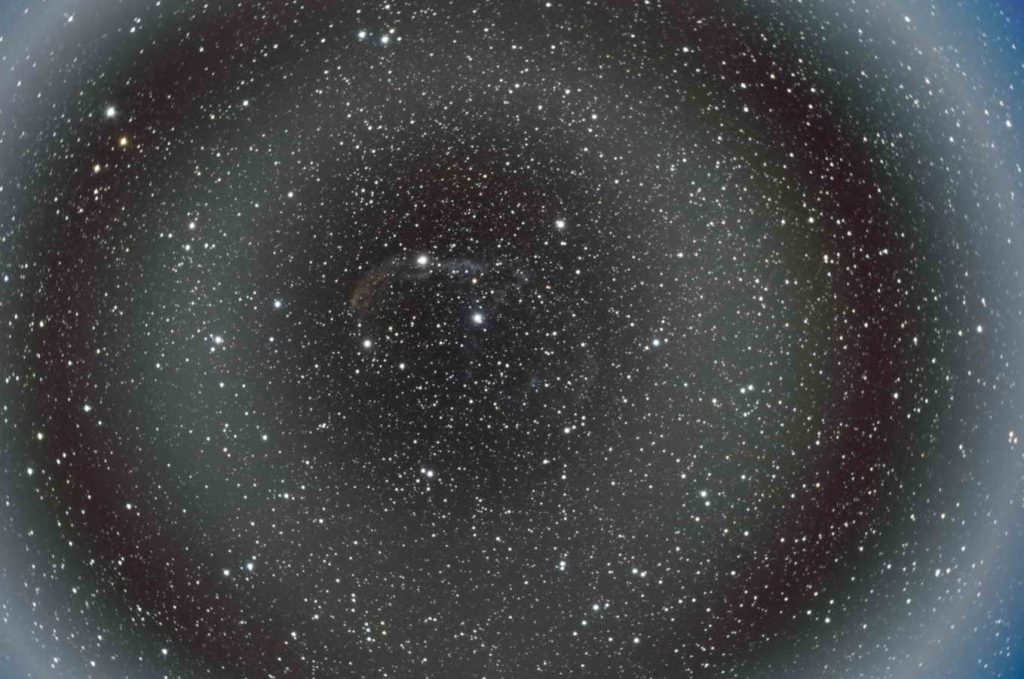
This reducer clearly shows a large amount of concentric gradients and uneven field illumination. It appears more on images like this because it contains a lot more data than the others (almost 6 hours) which accentuates slight differences in illumination, as well as images that were taken in strong light pollution. These nebulous deep sky objects also require aggressive stretching.
What Causes These Gradients?
One common source of irregular concentric circular banding in these types of systems is internal reflection sources in the optical train. Bright, unpainted or silver areas inside the telescope can cause reflections of light before reaching the sensor. However, I’m relatively confident I don’t have many such internal reflections (at least major ones) because these issues go away appreciably when the focal reducer is removed and nothing else (except focus) is changed. I also painted the lighter parts black inside the optical train as well as in the focal reducer itself. Here is the elephant stack again with the focal reducer:
Here is a substantially larger amount of data (16 hours) on the same target without the focal reducer:
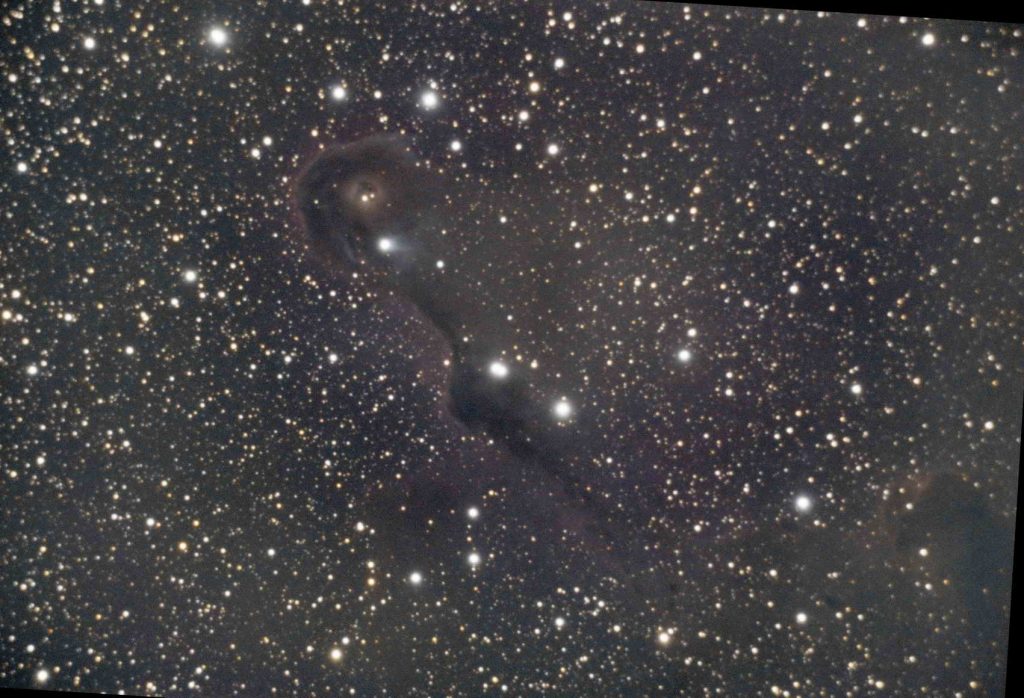
There are slight gradients (brighter in the center with light circles elsewhere), however with 8 times the data and substantially less unevenness, this focal reducer is clearly the main cause. I may explore internal reflections at some point (which are minor if present here), but it’s a huge can of worms to open; flocking the inside of the baffling tubes sounds very unpleasant because I don’t want to misalign my optics.
Why is the reducer to blame? It’s believed that these concentric rings are caused by the glass itself in ways that cannot be handled except by removing it entirely. The sensor, in my case that of a DSLR, is not perfect at absorbing the signal photons and some of them reflect off the sensor instead of being detected by it. They eventually return to the convex lens in the focal reducer and get sent back, this time focused into a ring-like pattern, to the sensor. Sometimes they reflect multiple times, leading to more outer “modes” of rings. The removal of the glass is the only way to handle these reflections, aside from those that find their way back to the sensor from the optical train itself.
This particular brand of focal reducer is great in many ways, but ultimately uses a cheap and simple design that doesn’t handle these reflections very well. Other, more expensive focal reducers seem to be showing me better results. More on this at the end.
Why do Flats Fail Here?
It seems like flats should correct this unevenness. They correct vignetting and dust, after all! But as you can see from the explanation above, these gradients are caused by reflections of the signal off of the camera sensor, off the focal reducer, back to the sensor. As a result, the strength and distribution of this effect is dependent on the exact subject being imaged: the distribution and brightness of all of the stars, nebulosity and other features in the subject. When flats are taken, they’re taken with a uniform and even (and very bright) light source by design. This does not properly reproduce the same effect (to the same extent, at least) in the flats, which leads to imperfect calibration no matter how well the flats are taken.
It gets worse! There’s no way to adequately obtain a calibration frame for this effect that doesn’t affect the image in other ways (trust me, I’ve spent an abhorrent amount of hours taking and testing flats). You can’t isolate the internal reflections from the signal without imaging the signal itself, and imaging the signal itself as a “flat” includes, you guessed it, the signal; how can you disentangle the two contributions? The closest I’ve come is by taking sky flats with exposures as long as the lights, with a handful of t-shirts over the edge, with tracking turned off to prevent starlight from accumulating in points. Unfortunately this still doesn’t do a perfect job, and using this reducer on hours of data on deep sky targets is probably exceeding its reasonable usefulness.
Final Words
This focal reducer is great for visual usage, bright solar system targets, and brighter DSOs. However, fainter DSOs that require extreme stretching, large integration times and faint nebulosity suffer from the circular artifacts shown above.
Because of its low price point and great image quality for bright subjects, this is a great choice for beginners working with SCTs who want a reliable focal reducer. However, the cheap nature of the hardware and 2-lens design will definitely become apparent for highly-stretched images with larger integration times, although I must admit that most people leave SCTs for deep sky imaging long before I do, and I push my 8se to the max of its capabilities.
These rings were only really solved by removing the focal reducer, although minor remaining imperfections also suggest imperfect flocking (leading to mild internal reflections). I tried out a much more expensive reducer from Starizona with great success; you can check that out here!
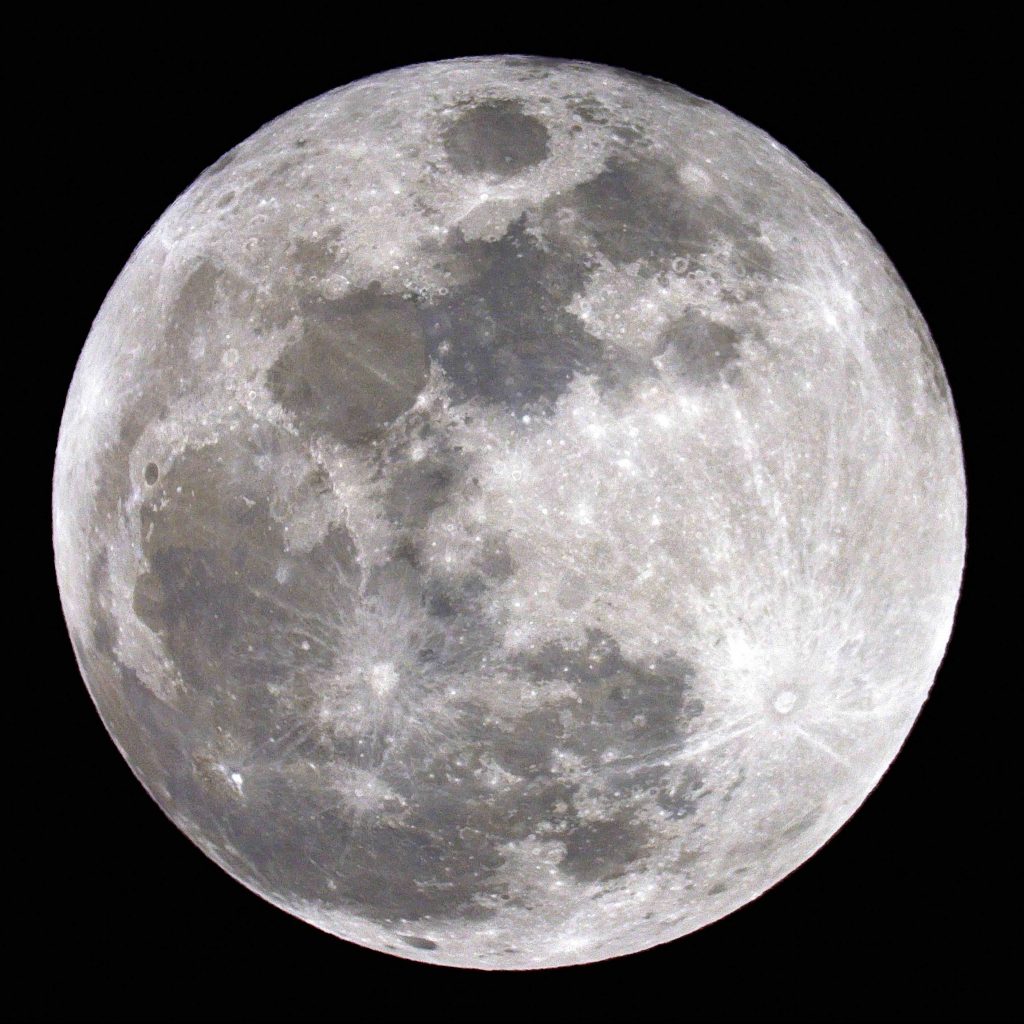
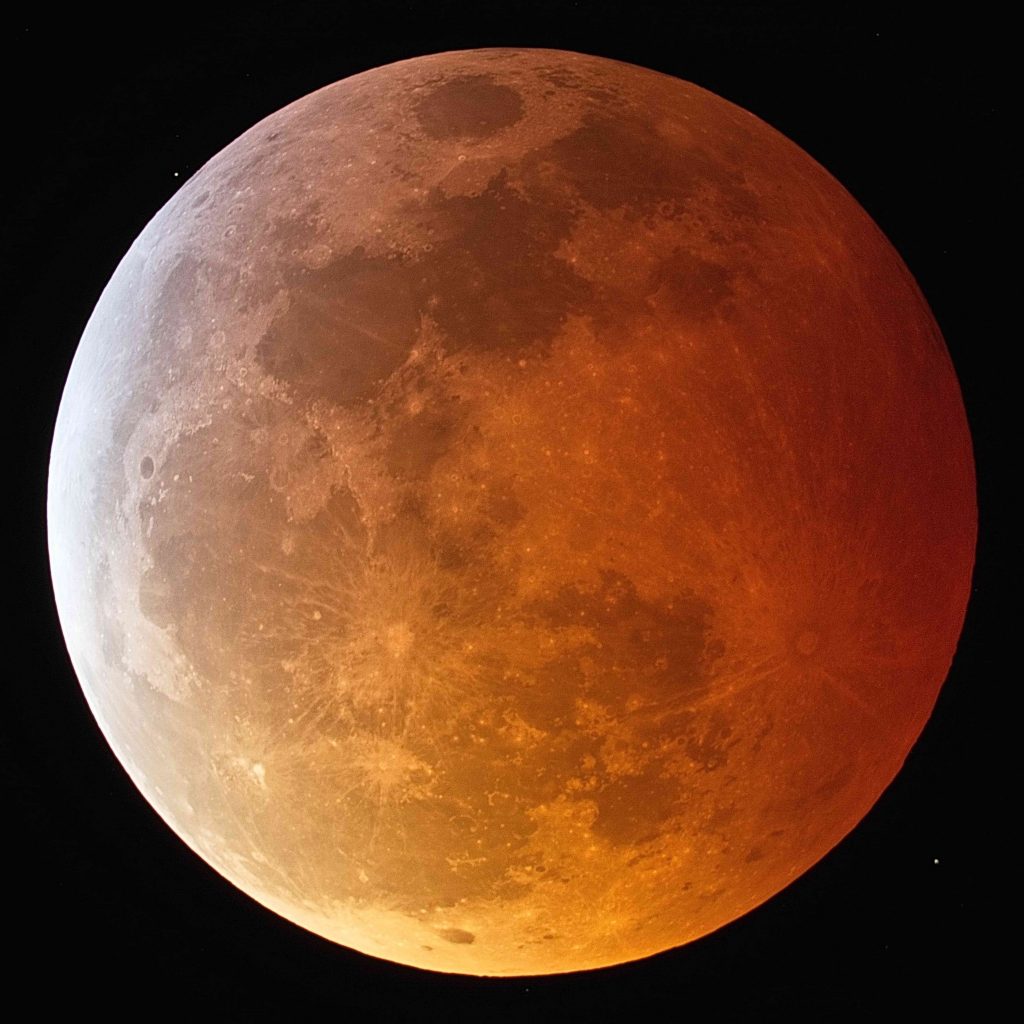
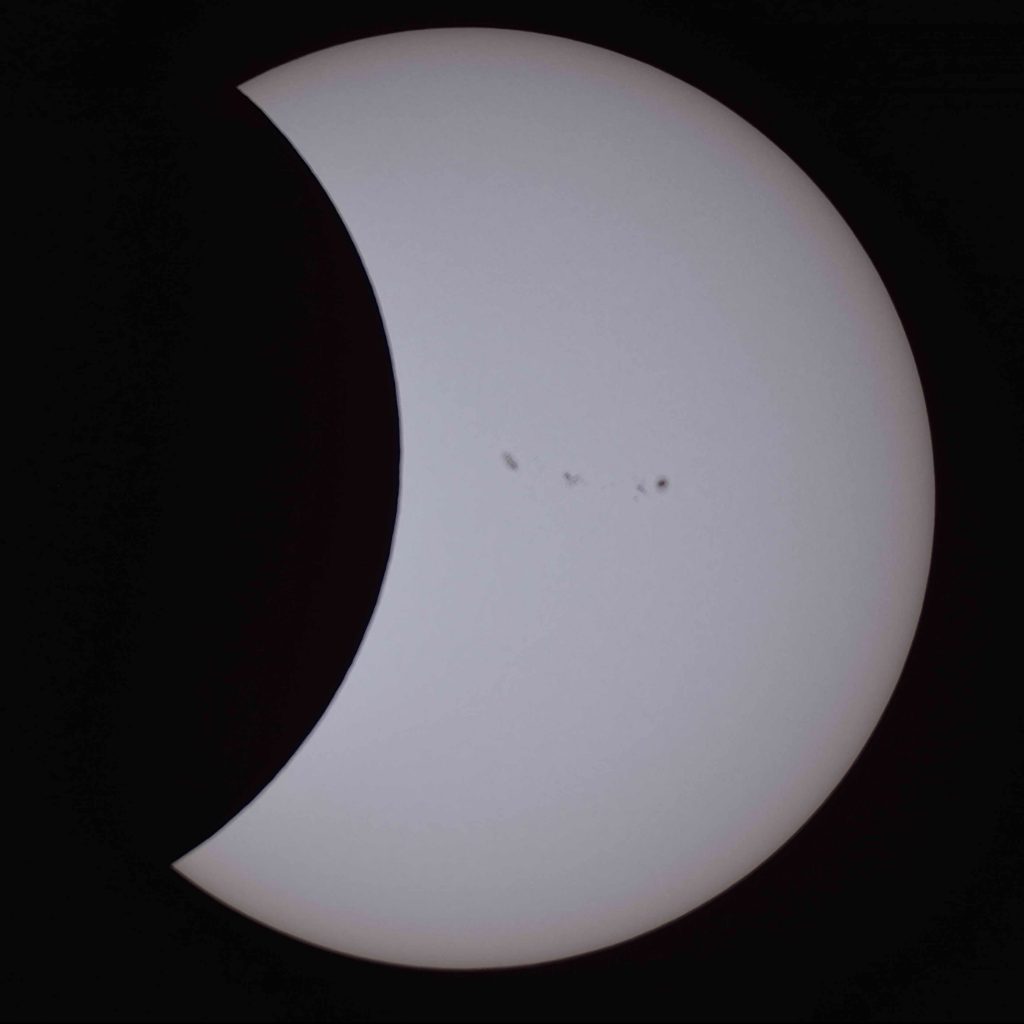
Hairstyles says:
whoah this blog is magnificent i love reading your posts. Keep up the great work! You know, a lot of people are looking around for this information, you could help them greatly.
Christian says:
Hello Alex,
thank you for all information about Antares reducer.
You’re said that the distance is 49mm since reducer back to the sensor. I had believe understand that the 82mm was from the back and not to the front. For a Canon DSLR the distance between sensor and dslr front is 44mm. If I understood, I do must insert a 5mm ring between the reducer and my dslr ? Is ok for you ?
Thank you again
Christian
Alex says:
Hey there, so I haven’t owned this in awhile so I can’t test, however I believe I updated something in this article that wasn’t accurate, and if my memory serves me, this statement is now accurate:
“leading to a necessary distance of 82mm from the front of the reducer to the imaging camera’s sensor; this only leaves around 49mm of distance from the back of the reducer to your imaging sensor, making the standard Celestron t-adapter far too long to place the sensor at the right place if you want to maximize its performance and get the exact right focal length for your telescope”
I’m trusting my old writing here, but I believe then it’s NOT 82mm from the back. Not 100% certain though… You may have to try both ways to find what’s best for your setup, or consult other who have used this one with their experiences.
Alex says:
You may find this helpful:
https://www.cloudynights.com/topic/265166-f63-reducer-spacing-for-sct/#entry3367628
Jurgen Schmoll says:
Thank you for this article, which explains a lot! I have a 14″ Meade SCT with a Canon DSLR, and I was driven mad by those rings. I used the Antares reducer, and now changed to a Celestron I borrowed.While the Celestron copes better with the larger field curvature of the large SCT, the rings are still there. I thought already they may be ghosts created by the optics, and now I get why flats do not work here. I wonder if an optical design with a larger curvature of the last glass/air surface would help to spread this ghosting out better.
Alex says:
Sorry for the delay in approving the comment!
I also tried the Celestron one and truthfully it wasn’t better than the Antares.
The main issue is multiple reflections, and any glass can facilitate that process. The most helpful thing would be minimally-reflective glass, multiple internal optical elements, and/or a lowly-reflective optical *sensor*, as the DSLR sensor can send a lot of light back at it…